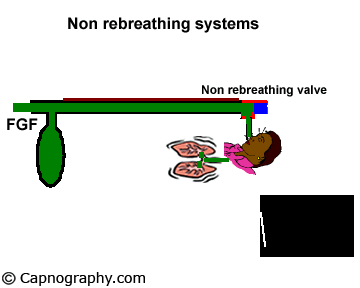Non rebreathing system
Bhavani Shankar Kodali MD
Professor and Chair of Anesthesia, Associate Professor
JIPMER, Pondicherry, India Harvard Medical School
|
Functional analysis

Functional analysis: When the patient takes a breath, or if the reservoir bag is squeezed, the inspiratory unidirectional valve opens and the gases flow into the patient’s lungs(Fig.1). The expiratory unidirectional valve closes the expiratory port during spontaneous breathing. The inspiratory unidirectional valve itself closes the expiratory port during controlled ventilation. At the start of expiration, the inspiratory unidirectional valve returns back to position and expiration takes place through the expiratory port, opening the expiratory valve.
The fresh gas flow (FGF) should be equal to the minute ventilation (MV) of the patient. These systems satisfy all four essential requirements, but are not very popular because of the following reasons:
1) Fresh gas flow has to be constantly adjusted and is not economical.
2) There is no humidification of inspired gas.
3) There is no conservation of heat.
4) They are not convenient as the bulk of the valve has to be positioned near the patient.
5) The valves can malfunction due to condensation of moisture and lead to complications.

 Twitter
Twitter Youtube
Youtube










